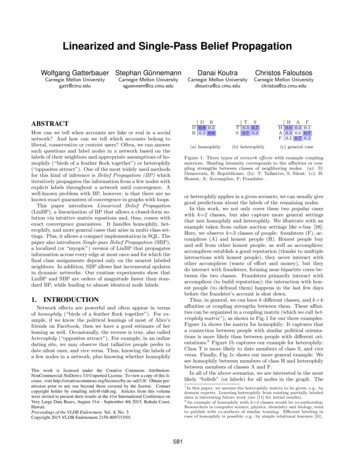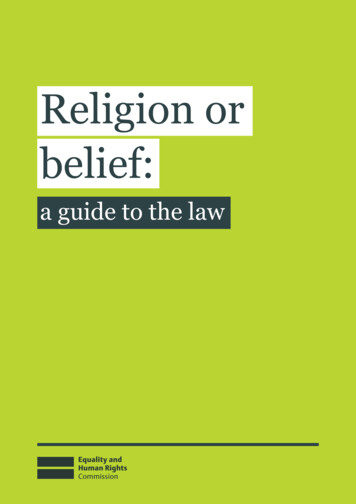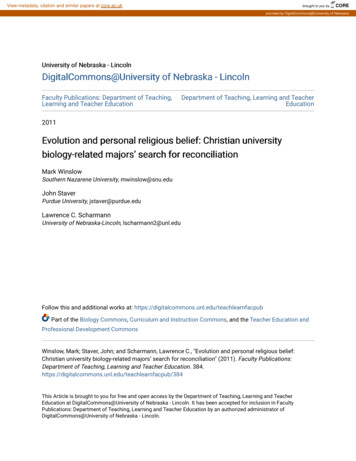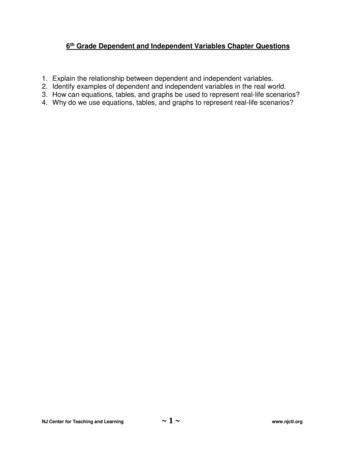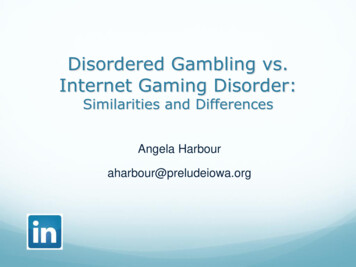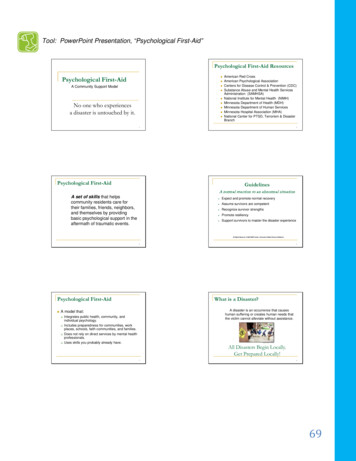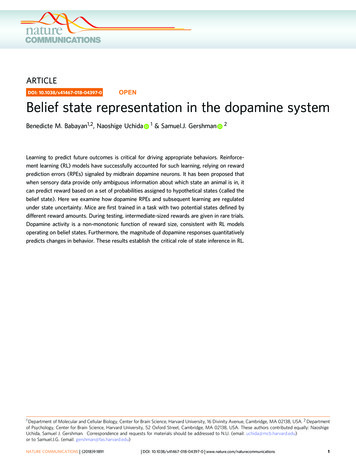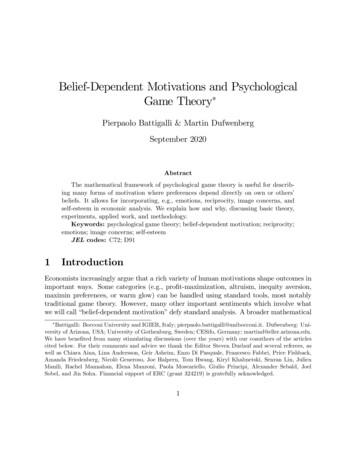
Transcription
Belief-Dependent Motivations and PsychologicalGame TheoryPierpaolo Battigalli & Martin DufwenbergSeptember 2020AbstractThe mathematical framework of psychological game theory is useful for describing many forms of motivation where preferences depend directly on own or others’beliefs. It allows for incorporating, e.g., emotions, reciprocity, image concerns, andself-esteem in economic analysis. We explain how and why, discussing basic theory,experiments, applied work, and methodology.Keywords: psychological game theory; belief-dependent motivation; reciprocity;emotions; image concerns; self-esteemJEL codes: C72; D911IntroductionEconomists increasingly argue that a rich variety of human motivations shape outcomes inimportant ways. Some categories (e.g., pro t-maximization, altruism, inequity aversion,maximin preferences, or warm glow) can be handled using standard tools, most notablytraditional game theory. However, many other important sentiments which involve whatwe will call “belief-dependent motivation”defy standard analysis. A broader mathematicalBattigalli: Bocconi University and IGIER, Italy; pierpaolo.battigalli@unibocconi.it. Dufwenberg: University of Arizona, USA; University of Gothenburg, Sweden; CESifo, Germany; martind@eller.arizona.edu.We have bene ted from many stimulating discussions (over the years) with our coauthors of the articlescited below. For their comments and advice we thank the Editor Steven Durlauf and several referees, aswell as Chiara Aina, Lina Andersson, Geir Asheim, Enzo Di Pasquale, Francesco Fabbri, Price Fishback,Amanda Friedenberg, Nicolò Generoso, Joe Halpern, Tom Hwang, Kiryl Khalmetski, Senran Lin, JulienManili, Rachel Mannahan, Elena Manzoni, Paola Moscariello, Giulio Principi, Alexander Sebald, JoelSobel, and Jin Sohn. Financial support of ERC (grant 324219) is gratefully acknowledged.1
framework called “psychological game theory” (PGT), pioneered by Geanakoplos, Pearce& Stacchetti (1989) (GP&S) and further developed by Battigalli & Dufwenberg (2009)(B&D), provides adequate modeling tools by letting the utility of outcomes depend onendogenous beliefs.1 We explain how and why.Among the many belief-dependent motivations that we cover, three main categorieswill receive particular attention:emotions, including guilt, disappointment, elation, regret, joy, frustration, anger,anxiety, suspense, shame, and fear;reciprocity, or the inclination to respond to kindness with kindness and to be unkindto whoever is unkind;image concerns, e.g., when someone wants others to believe that he is smart, altruistic, or honest.For each of these, we will provide a detailed discussion of main features, possible application, and a review of the relevant literature, including related experimental test. Here inthe Introduction, we provide early exposure to key ideas via three examples that illustratethese categories:Example 1: Guilt & tipping This example involves the emotions category. Psychologists Baumeister, Stillwell & Heatherton (1994) argue that “the prototypical cause of guiltwould be the in‡iction of harm, loss, or distress on a relationship partner” and that if“people feel guilt for hurting their partners . and for failing to live up to their expectations, they will alter their behavior (to avoid guilt) in ways that seem likely to maintainand strengthen the relationship”(see p. 245; cf. Tangney 1995). That outlook is re‡ectedin the following vignette:Tipper feels guilty if she lets others down. When she travels to foreign countries,and takes a cab from the airport, this in‡uences the gratuity she gives. Tippergives exactly what she believes the driver expects to get, to avoid the pang ofguilt that would plague her if she gave less.To model this, consider game form G1 where Tipper (player 2) chooses tip t 2 f0; 1; :::; M gand M 0 is the amount of money in her wallet. The driver (player 1) is not active, and there is no future interaction. His (material) payo is t. Choice t thus pins1See also Gilboa & Schmeidler (1988) who in another pioneering contribution on “informationdependent games” anticipated some of the themes that GP&S and B&D developed in more depth. Fornow dated introductions to the older PGT literature, see Attanasi & Nagel (2008) and Dufwenberg (2008).2
down an end-node. Tipper’s material payo is (Mt). However, her utility equals (M t)t] , where is 1’s expectation of t (which Tipper can only guess) and2 [0isasensitivityparameter measuring how much Tipper su ers when she lets 1 down.2 (Also, [ t] : maxf t; 0g.) In words, Tipper’s utility equals own money minus a pangof guilt which is proportional to how much less the driver gets than what he expects to get.Tipper’s behavior in the vignette is expected utility maximizing if 2 1. The presence ofin her utility makes it belief-dependent, leading to what is called a “psychological game”(p-game) here given by G1 . The key characteristic is that utility at an end-node dependson beliefs, in this case that 2’s utility at t depends on 1’s beliefs (via ). Had we hada traditional game, utilities would be de ned on end-nodes independently of beliefs andTipper’s best choice would be independent of her guess of .[G1 and G1 ]Terminology Example 1 illustrates key concepts we rely on throughout: A game formspeci es the structure of a strategic situation (the “rules of the game”): the players, howthey can choose, and the material consequences (typically money) of players’actions. Wereserve the term payo s for material consequences. Unless players are expected payo maximizers, payo s do not represent preferences over end-nodes. These are instead givenby utility functions (or utilities). Whereas in traditional game theory utilities arede ned on end-nodes only, in PGT they also depend on features of beliefs about behavior, like in Example 1, and higher-order beliefs. Such beliefs are determined by thestrategic analysis, i.e., they are endogenous. We use the term motivations to distinguishconceptually di erent parts that may a ect utility. Tipper is a ected by two motivations:own money and guilt. We use the term belief-dependent to describe if a motivation orutility depends on beliefs. Tipper’s rst motivation (own money) is not belief-dependentwhile the second one (guilt) is, which implies that Tipper’s utility is belief-dependent.We call psychological game, or p-game for short, the model obtained by appendingbelief-dependent utilities to a given game form.Example 2: Reciprocity in the battle-of-the-sexes The idea that people wish tobe kind towards those they perceive to be kind, and unkind towards those deemed unkind,is age-old.2 Early academic discussions can be found in anthropology (Mauss 1954), sociology (Gouldner 1960), social psychology (Goranson & Berkowitz 1966), biology (Trivers2Fehr & Gächter (2000, p. 159) reproduce a 13th century quote from the Edda that conveys the spirit:“A man ought to be a friend to his friend and repay gift with gift. People should meet smiles with smilesand lies with treachery.” Dufwenberg, Smith & Van Essen (2013, Section III) give more examples, frompopular culture, business, and experiments. Sobel (2005) provides a broad critical discussion.3
1971), and economics where the pioneer is Akerlof (1982), who analyzed “gift-exchange”inlabor markets. Akerlof had the intuition that reciprocity would imply a monotone wagee ort relationship (at least up to the level of a “fair wage”), and he posited that such arelationship exists. However, he did not engage in mathematical psychology and formaldescription of the underlying a ective processes. Rabin (1993) realized that such an approach could bring about a generally applicable model, which he developed. Our secondexample is taken from him.[G2 ]Consider game form G2 . If the players were motivated solely by material payo s wewould have a traditional game, with two equilibria: (opera, opera) and (boxing, boxing).These strategy pro les remain equilibria in Rabin’s model, where players’ utilities area ected by reciprocity, but (opera, boxing)3 is an additional equilibrium. We describethe underlying intuition: The players are “unkind” to each other, in the sense that givenequilibrium expectations they minimize each other’s material payo s (to be 0 rather than1). Each player sacri ces own material payo in the process (getting 0 rather than 12 ),but the desire to reciprocate the perceived unkindness of the co-player is strong enough tomake it worthwhile.Section 2 explains in more detail why modeling reciprocity involves PGT. The reasonis that kindness depends on beliefs. Here we quote Rabin (p. 1285), who compares the(boxing, boxing) and (opera, boxing) equilibria, highlighting a non-standard aspect of hismodel:In the natural sense, both of the equilibria . are strict: each player strictlyprefers to play his strategy given the equilibrium. In the equilibrium (boxing,boxing), player 1 strictly prefers playing boxing to opera. In the equilibrium(opera, boxing) player 1 strictly prefers opera to boxing. No matter what payo sare chosen, these statements would be contradictory if payo s depended solelyon the actions taken.Example 3: Status & conformity Our third example illustrates an image concernas modeled by Bernheim (1994). A special case goes as follows: Agents in a populationare uniformly distributed on T [0; 2], where t 2 T is an agent’s “type” of preferencefor “brightness of clothing”. Each agent simultaneously chooses a (garment) color c 2 Tto wear. All agents observe these choices, and form beliefs about the type of the chooserconditional on the choice. Let tc denote the expected type of an agent who chose c. An3Which is the coordination failure with smaller material incentives to deviate.4
agent of type t’s utility equals (t c)2 (1 tc )2 . In words, he su ers quadratic lossesof (i) letting his chosen color deviate from the one he favors, and of (ii) status by beingperceived as having an expected type that deviates from 1 (the “fashion standard”).Focusing on the case where agents’types are private information, Bernheim analyzesthis model as a signaling game. He looks for equilibria where the “sender” (the onlyactive player) maximizes expected utility given the way beliefs are formed, while beliefsare formed consistently with Bayes’ rule given how choices depend on types. He arguesthat a plausible class of equilibria involve pooling at c 1. Under our parameterization,such pooling can be universal, if out-of-equilibrium inferences— which cannot be pinneddown by Bayes’rule— satisfy (e.g.) that tc 2 f0; 2g, for all c 6 1.4The example is interesting to us for two reasons. First, aspect (ii), mentioned above,makes utility belief-dependent,5 and so creates a p-game G3 . Second, consider a modi edversion of G3 , call it G3 , where agents’types are observed ex post. Obviously, an agent oftype t will be believed to have type t, regardless of his choice c. In the unique equilibrium,he will rely on a dominant strategy: c t, so the prediction will di er from Bernheim’s. Astriking observation, from a game-theoretic point of view, is that the di erence between G3and G3 concerns information across end-nodes. It is imperfect in G3 but perfect in G3 .In traditional game theory, information across end-nodes never a ects predictions, and istherefore not even speci ed. That this property does not extend to p-games shows thatinformation at end-nodes (and more generally the information players have when they areinactive) should be carefully speci ed.The preceding three examples illustrate di erent belief-dependent motivations that canbe modeled with belief-based utility and p-games. Awareness of and interest in PGTis on the rise, yet far from universal. We explain what PGT is and what motivationscan be modeled, highlighting a variety of idiosyncratic features. We discuss basic theory,experimental tests, and applied work. Although we cite a lot of papers, our primary goalis to highlight the structure and potential of various forms of work involving PGT. Ourstyle is semi-formal, presenting some notions verbally rather than mathematically. Readerswho wish to dig deeper should compare with relevant passages of GP&S, B&D, and otherarticles. This includes, in particular, the recent methodological article by Battigalli, Corrao& Dufwenberg (2019) (BC&D), a text we frequently draw connection to.Our discussion is mainly focused on showing how to functionally represent beliefdependent motivations. We do not critically evaluate how to best derive predictions (via4If an agent of type t stays with the proposed equilibrium he gets utility (t 1)2 0. If he deviates,the best way to do so would be to choose c t, in which case he would get utility 0 (1 0)2 (or0 (1 2)2 ), hence he cannot gain by deviating.5Note that tc is a feature of an endogenous belief, because it is derived from an initial belief abouttypes and choices by conditioning on the observed choice.5
“solution concepts”). Rather, we keep our analysis of strategic reasoning simple, limited toeither (a few rounds of iterated) elimination of non-best replies, or to informally applyingan equilibrium concept. A broader discussion of solution concepts would be an importanttopic, but a proper treatment warrants its own article.6 Compared to GP&S and B&D,we greatly simplify the analysis by letting utility depend only on (own and others’) beliefsabout behavior and personal traits ( rst-order beliefs). Yet, we generalize other importantaspects, e.g., by distinguishing between plans, which are beliefs/predictions about ownbehavior, and actual behavior. This allows us to encompass within a coherent theoreticalframework essentially all the extant applied-theory models with belief-dependence,7 including some that were not thought as connected to psychological game theory. All formsof belief-dependent motivation are thus analyzed by means of a general notion of subjectively rational planning, which accounts for the possibility of dynamically inconsistentpreferences, as in— say— models of expectation-based loss aversion.In Sections 2-5 we elucidate a wide palette of sentiments that PGT can explore, startingwith the three categories of motivations mentioned above: reciprocity, which was the rstapplication of PGT (2), emotions (3), and image concerns (4). Section 5 discusses otherimportant, but less explored belief-dependent motivations. Section 6 builds on the modelsand examples analyzed earlier to delve into the abstract formal framework of PGT. Readerswho like formal analysis may want to read Section 6 before the preceding ones. Section7 discusses experiments, and Section 8 applications. Section 9 wraps up and concludes.Finally, Section 10 expands on methodological issues.2ReciprocityRabin’s model of kindness-based reciprocity pioneered using PGT to explore the generalimplications of a particular motivation. He focuses on simultaneous-move game forms, aswe illustrated via G2 . But, as Rabin himself points out (p. 1296)— from the perspective ofapplied economics— it is important to also consider extensive game forms with a non-trivialdynamic structure. Dufwenberg & Kirchsteiger (2004) took on that task,8 and we sketchtheir approach. Game form G4 (akin to their 1 ) is useful for introducing main ideas:[G4 ]6For detailed explorations of solution concepts for p-games, see B&D and BC&D.Anger from blaming intentions (Section 3.3) and guilt from blame (Section 5) are notable exceptions.8The main di erence between Rabin’s and Dufwenberg & Kirchsteiger’s approaches concerns whichclass of game forms is considered, but there are other di erences too. See Dufwenberg & Kirchsteiger(2004, Section 5; 2019).76
A crucial building block of the analysis concerns player i’s kindness to j, denoted ij ( ).9It is the di erence between the payo (i.e., the material/monetary reward) i believes j gets(given i’s choice) and a comparison payo C that i computes as follows: C is the averageof the minimum and the maximum payo that i believe j could get, for other choices ofi.10 In G4 , if 1 believes there is probability p that 2 would choose take, we get1[5 (p 9 (1 p) 1)] 2 4 p,12 (stay; p) 521p) 1[5 (p 9 (1 p) 1)] 4 p 2,12 (reach; p) p 9 (121[1 9] 4, and21 (take) 121[1 9] 4.21 (give) 92Note that i’s kindness to j has the dimension of the (expected, material) payo of j, itranges from negative to positive, and it may depend on i’s beliefs (as it does for 1 in G4 ).Player i is taken to maximize (the expectation of) a utility that depends on actions andbeliefs according to a functional form of the following kind:ui ( ) i() iij ()ji (),(1)where i ( ) is i’s (material) payo function and parameter i0 re‡ects i’s reciprocitysensitivity. The desire to reciprocate kindness, as intuitively described in the Introduction,is captured via “sign-matching;” i ij ( ) ji ( ) is positive only if the signs of ij ( ) and ji ( )match.11 To illustrate in G4 : if 2 is high enough, 2 wants to “surprise” 1, i.e., 2’s bestreply is take if p 21 and give if p 12 .We make several PGT-related observations:(i) Player 2 chooses between end-nodes. So, in traditional game theory, her optimalchoice would be independent of beliefs. This is not the case with reciprocity. In G4 , 2’soptimal choice depends on p, 1’s belief. This illustrates that G4 , when played by agentsmotivated by reciprocity, is a p-game.(ii) Relatedly, backward induction cannot be used to nd 2’s subjectively optimal choiceindependently of beliefs. Player 2 must consult her beliefs about p to compute his expectedutility-maximizing action.9Here, and in other expressions below, the dot symbol ( ) represents on one or more variables, such aschosen actions (terminal history reached) and beliefs.10This de nition neglects an important aspect that is commented on below under the heading “Dealingwith ‘bombs.’”11Player i cannot know j’s beliefs and must form beliefs about ji ( ), denoted iji ( ) by Dufwenberg &Kirchsteiger, who plug iji ( ) into ui . Our formulation, (1), conformant with Section 6 below, relies on rst-order beliefs only, but has equivalent implications.7
(iii) In traditional game theory, nite perfect-information games have equilibria (justi able by backward induction) where players rely on degenerate, deterministic plans (intended choices). This is not the case in G4 , for high values of 2 . We have not de nedequilibrium here, but suppose we have a notion that requires 1 to correctly anticipate 2’splan (and that plans are carried out), and for 2 to anticipate that 1 will do so. (Dufwenberg& Kirchsteiger’s equilibrium has that property.) If 2 plans to choose take, and 1 anticipates that 2 plans to choose take, then p 1. But, if 1 anticipates that, then (as explainedabove) 2’s best response would be give, not take. An analogous argument rules out anequilibrium where 2 plans to choose give.Our next example, the Ultimatum Mini-game form G5 , gives further insights regardingreciprocity, and will be used for later comparisons as well:[G5 ]Reasoning as before (with p now 1’s belief about reject), 12 (greedy; p) is strictly negativefor all p.12 If 2 is large enough, the utility maximizing plan for 2 is reject. Suppose thisis the case. What should 1 do? If 1 0, meaning that 1 is sel sh, then 1 would choosefair (since 5 0). If instead 1 is large (enough), then there are two possibilities. The rst is that 1 chooses fair. To see why, suppose that (at the root, i.e., before the startof play) 1 believes that 2 believes that 1 plans to choose fair. Then 1 believes that 2believes that 2 is not (as evaluated at the root) a ecting 1’s payo . That is, at the root,it holds that 21 ( ) 0, implying that, to maximize his utility, 1 should act as if sel shand choose fair (since 5 0). The second, very di erent, possibility is that 1 choosesgreedy, despite anticipating that 2 will choose reject. This is a “street ght”outcome, withnegative reciprocity manifesting along the path of play. To get the intuition, suppose 1believes that 2 believes (at the root) that 1 is going to choose greedy. Then 1 believes that2 is planning to generate a payo of 0 rather than 9 for player 1. In this case, 2 wouldbe unkind. Since 1 is large, 1 reciprocates (in anticipation!) choosing greedy, therebygenerating a payo of 0 rather than 5 for player 2.The analysis here re‡ects a key feature of the approach, namely that players’kindnessis re-evaluated at each history. For example, 2’s kindness to 1 at the root may be zero (if2 believes 1 plans to choose fair) and yet 2’s kindness after 1 chooses greedy would at thattime not be zero.13Dealing with “bombs” The account of reciprocity theory just given glosses over asubtle issue which we now ‡ag. To illustrate, let GX5 be a modi cation of G5 such thatMore precisely, 12 (greedy; p) (1 p) 1 ( 21 5 12 [(1 p) 1]) 2 p2 .Our account has been sketchy; see van Damme et al. (2014; Section 6, by Dufwenberg & Kirchsteiger)for a fuller analysis of a large class of Ultimatum Game forms.12138
player 1 has a third choice at the root— X— which explodes a bomb, leaving each playerwith a material payo of 100.Recall how we de ned i’s kindness to j as the di erence between the payo i believes jgets and the average of the minimum and maximum payo that i believes j could get. GX5can illustrate how, in some game forms, absurd implications follow unless the calculationof “the minimum payo i believes j could get”is modi ed to not consider choices that hurtboth i and j. In G5 we concluded that 1’s kindness when choosing greedy was negativep, as noted in a footnote). Reasoning analogously, in GX( 12 (greedy; p) 25 1’s2kindness of choice greedy would instead be positive.14 Arguably, this is implausible. Whilehurting everyone would surely be unkind, not doing so should not automatically renderother choices kind. The kindness (for a given p) of choice greedy should rather be the samein GX5 and G5 .Dufwenberg & Kirchsteiger (2004), as well as Rabin, propose kindness de nitions thatachieve this, by calculating “the minimum payo j could get”without regard to so-called“ine cient strategies”that hurt both i and j. Their approaches, while to a degree similarin spirit, di er in details. The (somewhat contentious) issues involved are too subtleto warrant coverage here. We refer to Dufwenberg & Kirchsteiger (2019) for a detaileddiscussion, including a response to a related critique by Isoni & Sugden (2019).Related literature Dufwenberg & Kirchsteiger (2004) limit attention to certain gameforms without chance moves, a restriction Sebald (2010) drops, which allows him to addressbroader notions of “attribution” and “procedural concerns”. Sohn & Wu (2020) analyzesituations where players are uncertain about each other’s reciprocity sensitivities. Jiang &Wu (2019) discuss alternatives to the belief-revision rules of Dufwenberg & Kirchsteiger(2004). Dufwenberg, Smith & Van Essen (2013) modify the theory to focus on “vengeance;”players reciprocate negative but not positive kindness (achieved by replacing ji ( ) in (1)by [ ji ( )] ). All these authors hew close to Rabin. Alternative approaches are proposedby Falk & Fischbacher (2006) who combine reciprocity motives with preferences for fairdistributions,15 and Çelen, Schotter & Blanco (2017) who model i’s reciprocation to jbased on how i would have behaved had he been in j’s position.As PGT-based models gain popularity they will be increasingly used to do appliedeconomics. Most such work to date is based on reciprocity theory (and in particularDufwenberg & Kirchsteiger’s 2004 model). Topics explored include wage setting, voting,More precisely, 12 (greedy; p) (1 p) 1 ( 21 5 12 ( 100)) 48:5 p.So do Rabin (1993, p. 1298) as well as Charness & Rabin (2002) in appendix-versions of their socialpreference models. These models and the references in the main text are PGT-based. Levine (1998), Cox,Friedman & Sadiraj (2008), and Gul & Pesendorfer (2016) present reciprocity-related ideas which are notkindness-based and do not use PGT.14159
framing e ects, hold-up, bargaining, gift exchange, insolvency in banking, mechanism design, trade disputes, public goods, randomized control trials, memoranda of understanding,climate negotiations, communication, and performance-based contracts.163EmotionsFor a long time, neither psychologists nor economists paid much attention to emotions andhow they shape behavior. We recommend Keltner & Lerner’s (2010) handbook chapterwhich explains how while “founding gures in psychology” (in particular Charles Darwinand William James) paid signi cant attention to emotions, during most of the 20th centuryand “the heyday of behaviorism . emotions resided . outside the purview of observablemeasurement”and were considered “undeserving of scienti c inquiry”(p. 317).17 Furthermore, Elster (1996, 1998) forcefully argues that economists have neglected to study theemotions, despite that the topic is potentially of great importance. In his 1996 text hegoes so far as to note that “all human satisfaction comes in the form of emotional experiences”(p. 1368). He argues that by failing to recognize such an important source of utilityeconomists are potentially failing to get a correct grip on how decisions are formed.That view is corroborated by more recent developments in psychology. According toKeltner & Lerner, not only has (since 1980) “a robust science of emotion . emerged”(p. 317), but it has indicated that a large variety of emotions, each one in distinct ways,impacts well-being and behavior. The causalities are complex and hardly fully understood,but a key idea that is often stressed involves what since Lerner & Keltner (2000, 2001)has been called “appraisal-tendency.” Lerner, Li, Valdesolo & Kassam (2014) discuss theimplications for decision making and how “appraisal tendencies are goal-directed processesthrough which emotions exert e ects on judgments and decisions”(p. 479). The themes include how emotions a ect content and depth of thought, goal activation, and interpersonalassessments.18Reading these psychological discussions is highly inspiring, and we encourage economists to do so. Yet, at times, getting a full grip can be frustrating as the concepts and16See Dufwenberg & Kirchsteiger (2000), Hahn (2009), Dufwenberg, Gächter & Hennig-Schmidt (2011),Dufwenberg et al. (2013), van Damme et al. (2014; Section 6), Netzer & Schmutzler (2014), Dufwenberg& Rietzke (2016), Bierbrauer & Netzer (2016), Bierbrauer, Ockenfels, Pollak & Rückert (2017) Conconi,DeRemer, Kirchsteiger, Trimarchi & Zanardi (2017), Dufwenberg & Patel (2017), Jang, Patel & Dufwenberg (2018), Kozlovskaya & Nicolò (2019), Aldashev, Kirchsteiger & Sebald (2017), Nyborg (2018), LeQuement & Patel (2018), and Livio & De Chiara (2019).17Keltner & Lerner quote Skinner (1948): emotions are “the ctional causes to which we ascribe behavior” and “useless and bad for our peace of mind and our blood pressure.”18See also Keltner & Lerner’s Table 9.3 and the related discussion of attention, certainty, control coping,pleasantness, responsibility, legitimacy, and anticipated e ort.10
connections tend to be, not only overwhelmingly plentiful, but also informal. We suspect and hope that some complementary clarity can be brought to the table by invokinganalytical methods. PGT provides an adequate set of tools.19 In his previous article inthis Journal, Elster (1998) argued that emotions “are triggered by beliefs” (p. 49) andthat they can have important economic consequences. How “can emotions help us explainbehavior for which good explanations seem to be lacking?” he asked (p. 48). While helamented economists’dearth of attention to the issue, PGT has subsequently been put tosuch use, and there is more to do. In this section we focus on guilt (3.1), disappointment(3.2), anger (3.3), regret (3.4), and anticipatory feelings (3.5); we then o er some wrap-upremarks on emotions (3.6).3.1GuiltAmong the emotions, guilt has been explored the most using PGT.20 Motivated by workin psychology (e.g., Baumeister et al. and Tangney, cited in the Introduction), Battigalli& Dufwenberg (2007) develop a model allowing exploration of how (two versions of) guiltshapes strategic interaction in a general class of game forms. While most follow-up workhas been experimental (see Section 7), a few applied theory papers explored how guiltin‡uences marriage & divorce, corruption, deception, framing, tax evasion, public goods,embezzlement, and expert advice.21We provide (BC&D’s account of) Battigalli & Dufwenberg’s (2007) notion of “simpleguilt:”Player i experiences guilt when he believes that the payo j gets ( j ) is lower thanthe payo j initially expected given j’s rst-order beliefs j . This expectation is denotedE[ j ; j ], and it depends on j’s beliefs about (own and others’) actions.22 Speci cally, i 6 jmaximizes (the expectation of) a utility of the formui (z;j) i (z)i[E[ j ;j] j (z)] ,(2)where z is the sequence of chosen actions (terminal history, path, or end-node). Again,0 is a sensitivity parameter. As seen in the Introduction, Tipper’s behavior in G1 isi19See also Chang & Smith (2015) who elaborate on this theme.Reciprocity, which we do not count as an emotion, has been explored even more than guilt. See Azar(2019) for a statistical analysis of the bibliometric impact of PGT-based reciprocity and guilt theory.21See Dufwenberg (2002), Balafoutas (2011), Battigalli, Charness & Dufwenberg (2013), Dufwenberg &Nordblom (2018), Dufwenberg et al. (2011), Patel & Smith (2019), Attanasi, Rimbaud & Villeval (2019),and Khalmetski (2019).22The authors actually assume that i su ers only to the extent that he causes j to get a lower payo than j initially expected. Stating that precisely leads to a more complicated utility than the one seen here.However, best responses are identical, so we opt for the simpler version here.2011
captured if 2 1. We now discuss also a trust game form G6 .23 As
The preceding three examples illustrate di erent belief-dependent motivations that can be modeled with belief-based utility and p-games. Awareness of and interest in PGT is on the rise, yet far from universal. We explain what PGT is and what motivations can be modeled, highlighting a variety of idiosyncratic features. We discuss basic theory,

